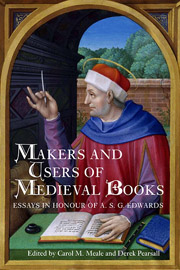Book contents
- Frontmatter
- Contents
- List of Illustrations
- Contributors
- Preface
- List of Abbreviations
- COMPOSITION
- Winning and Wasting in Wynnere and Wastoure and Piers Plowman
- The Reference Work in the Fifteenth Century: John Whethamstede's Granarium
- Pageants Reconsidered
- COMPILATION
- PRODUCTION
- OWNERS, PATRONS, READERS
- AFTERLIVES
- A. S. G. Edwards: List of Publications
- Index of Manuscripts and Early Printed Books
- General Index
- Tabula Gratulatoria
The Reference Work in the Fifteenth Century: John Whethamstede's Granarium
from COMPOSITION
Published online by Cambridge University Press: 05 May 2014
- Frontmatter
- Contents
- List of Illustrations
- Contributors
- Preface
- List of Abbreviations
- COMPOSITION
- Winning and Wasting in Wynnere and Wastoure and Piers Plowman
- The Reference Work in the Fifteenth Century: John Whethamstede's Granarium
- Pageants Reconsidered
- COMPILATION
- PRODUCTION
- OWNERS, PATRONS, READERS
- AFTERLIVES
- A. S. G. Edwards: List of Publications
- Index of Manuscripts and Early Printed Books
- General Index
- Tabula Gratulatoria
Summary
The Granarium of John Whethamstede ranks amongst the more ambitious intellectual undertakings of English monastic culture in the later Middle Ages. In the Granarium, Whethamstede, abbot of St Albans from 1420 to 1440, and again from 1452 until h s death in 1465, compiled over 1,500 entries on a very wide range of topics, primarily of relevance to ecclesiastical and classical history, arranged alphabetically, and distributed across four parts. This ‘granary’ – the term is a pun on Whethamstede's name (‘in loco frumenti’), but also a serious conceptualization of the reference work as a store of knowledge – drew on numerous sources. While the most important of these, such as Martinus Polonus’ Chronicon, Paulus Orosius’ Historiae, Valerius Maximus’ Facta et dicta memorabilia, or Ovid's Metamorphoses, are unsurprising, Whethamstede also made use of more obscure and more recent texts, such as the Dialogus inter Orthodoxumet Catechuminum attributed to Michael Pelagallo, or Andrea Fiocchi's De magistratibus Romanorum. Whethamstede had attended the council of Pavia in 1423 and remained deeply interested in conciliar debates; part one of the Granarium contains lengthy entries related to events at the Council of Constance (1414–18), and makes reference to the Council of Basel (1431-49). Whethamstede was also familiar with Italian humanist culture: Petrarch, Boccaccio and Leonardo Bruni all feature amongst his sources, while Boccaccio's Genealogiae deorum gentilium seems to have been a particular influence on part four of the Granarium. This monument to the resources available at a great house such as St Albans was not intended for purely local consumption.
- Type
- Chapter
- Information
- Makers and Users of Medieval BooksEssays in Honour of A.S.G. Edwards, pp. 13 - 33Publisher: Boydell & BrewerPrint publication year: 2014



